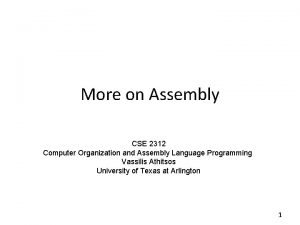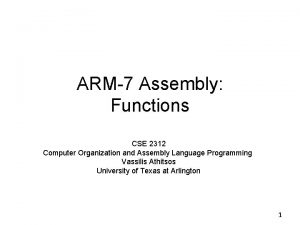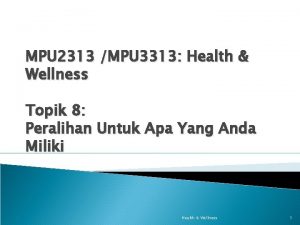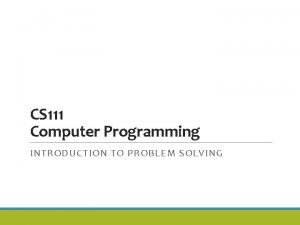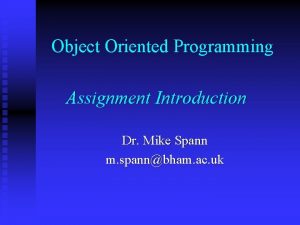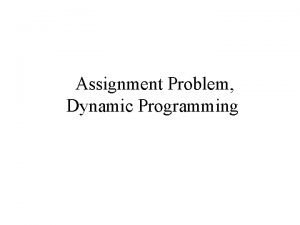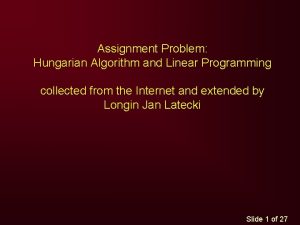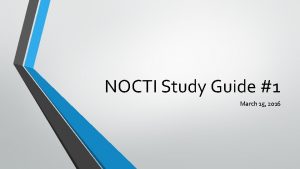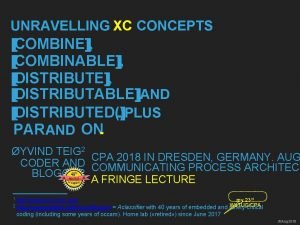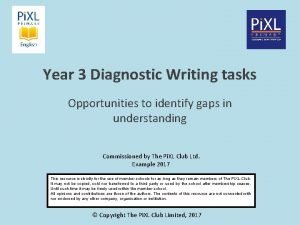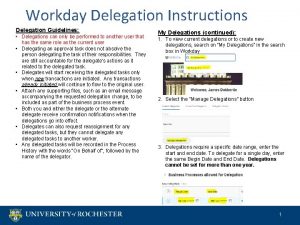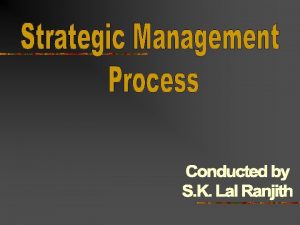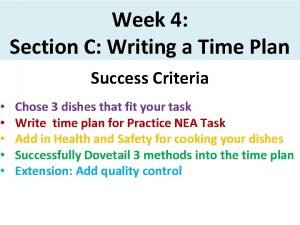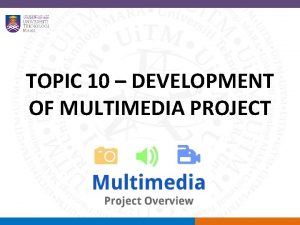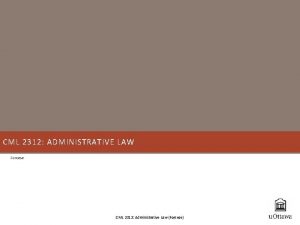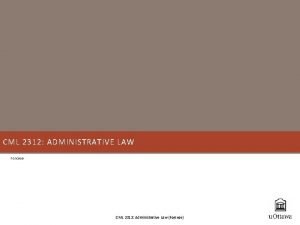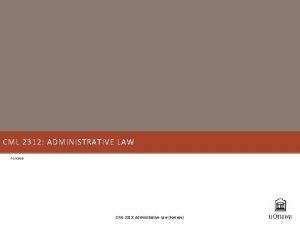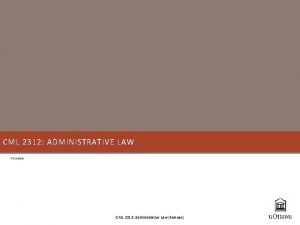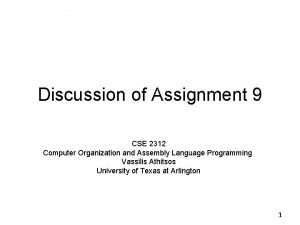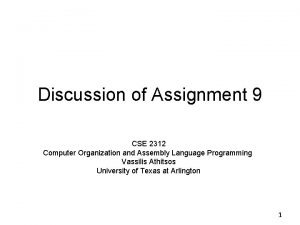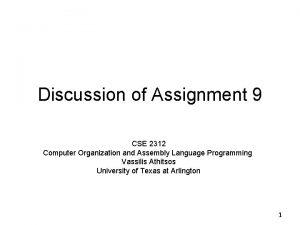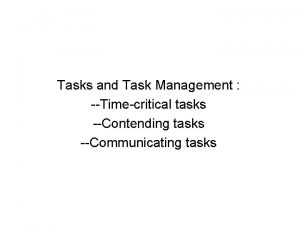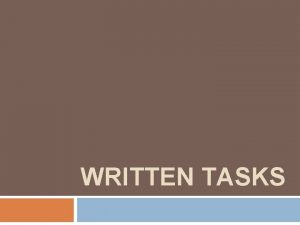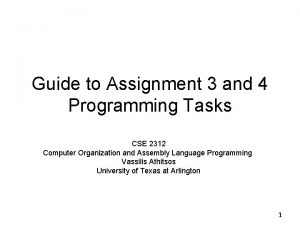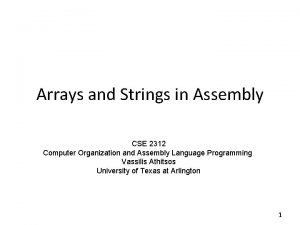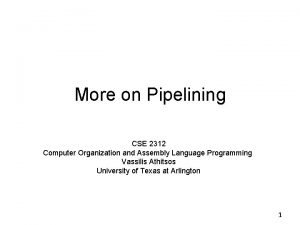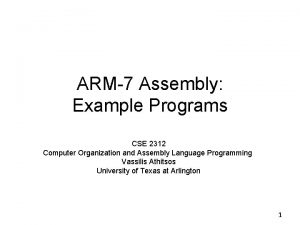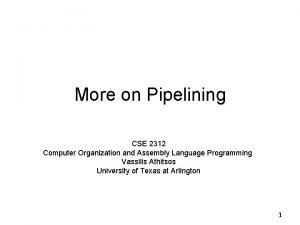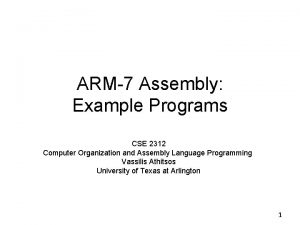Guide to Assignment 3 Programming Tasks CSE 2312




















- Slides: 20

Guide to Assignment 3 Programming Tasks CSE 2312 Computer Organization and Assembly Language Programming Vassilis Athitsos University of Texas at Arlington 1

Task 1 • Goal: convert a data file from one endian format to the other. • Program flow: – Open input and output files. – While there is input data to be processed: • Read the next record from the input file. • Convert the record to the other endian format. • Save the record to the output file. – Close input and output files. 2

Task 1 • Goal: convert a data file from one endian format to the other. • Program flow: – Open input and output files. – While there is input data to be processed: • Read the next record from the input file. • Convert the record to the other endian format. • Save the record to the output file. – Close input and output files. • If you use task 1. c, you just have to write the function that converts the record and saves it to the output file. 3

Converting the Record to the Other Endian Format. • You need to reorder the bytes of each integer in the record. • Pseudocode for reordering the bytes of the integer: – Convert the integer into an array of chars. • Use provided function integer_to_characters. – Reverse the order of the chars in that array. – Convert the array of chars back to an integer. • Use provided function characters_to_integer. • Then, you need to write the converted record on the output file. – Use provided function save_record. 4

Task 1 Sample Output (1) • Run on an Intel machine (little endian): . /a. out 0 test 1_little. bin test 2_big. bin read: Record: age = 56, name = john smith, department = 6 read: Record: age = 46, name = mary jones, department = 12 read: Record: age = 36, name = tim davis, department = 5 read: Record: age = 26, name = pam clark, department = 10 5

Task 1 Sample Output (2) • Run on an Intel machine (little endian): . /a. out 0 test 2_big. bin out 2_little. bin read: Record: age = 939524096, name = john smith, department = 100663296 read: Record: age = 771751936, name = mary jones, department = 201326592 read: Record: age = 603979776, name = tim davis, department = 83886080 read: Record: age = 436207616, name = pam clark, department = 167772160 • Since the machine is little endian and the input data is big endian, the printout is nonsense. 6

The diff Command • Suppose that you have run this command: . /a. out 0 test 1_little. bin test 2_big. bin • How can you make sure that your output (test 2_big. bin) is identical to test 1_big. bin? • Answer: use the diff command on omega. diff test 1_big. bin test 2_big. bin 7

Task 2 • Goal: do parity-bit encoding/decoding of a file. • Program flow: – Open input and output files. – While there is input data to be processed: • Read the next word W 1 from the input file. • If (number == 0) convert W 1 from original word to codeword W 2. • If (number == 1): – convert W 1 from codeword to original word W 2. – print out a message if an error was detected. • Save W 2 to the output file. – Close input and output files. 8

Task 2 • Goal: do parity-bit encoding/decoding of a file. • Program flow: – Open input and output files. – While there is input data to be processed: • Read the next word W 1 from the input file. • If (number == 0) convert W 1 from original word to codeword W 2. • If (number == 1): – convert W 1 from codeword to original word W 2. – print out a message if an error was detected. • Save W 2 to the output file. – Close input and output files. • If you use task 2. c, you just have to write the functions that convert between original words and codewords. 9

Task 2 Files • Task 2 works with bit patterns. • In principle, the input and output files could be binary. • Problem: difficult to view and edit (for debugging). • Solution: use text files. – Bit 0 is represented as character '0'. – Bit 1 is represented as character '1'. 10

Task 2 Unencoded File (in 1. txt) 101010011010001100101010000011010111100001110110 011111000011110010110111101000001101001111001 1010000011000011101110110100111 011011100001110110000011101000110000111101 000100000110110100111101101100101111001101000001 101001110010000011110101111001111101001110 0101100001110110100111000010101110 • This binary pattern contains the 7 -bit ASCII codes for: "The kangaroo is an animal that lives in Australia. " 11

Task 2 Encoded File (coded 1. txt) 101010011101000111001000001110101111100001111011100111111000011111001001101111001000001 1101001011101000001111011101010000011100 0011110111010010110110111100001111011000001 1110100011100001111101000001110110001101 001011011100101011101000001110100101101 010000010111010111110011111101000111001001100 001111011000110100101100001101011100 • This binary pattern is the parity-bit encoding for: "The kangaroo is an animal that lives in Australia. " 12

Task 2 - Sample Output (1) • Encoding: . /a. out 0 in 1. txt out 1. txt Start of translation: The kangaroo is an animal that lives in Australia. End of translation 13

Task 2 - Sample Output (2) • Decoding (no errors found): . /a. out 1 parity 1. txt out 2. txt Start of translation: The kangaroo is an animal that lives in Australia. End of translation 14

Task 2 - Sample Output (3) • Decoding (errors found): 1 parity 2. txt out 2. txt error detected at word 0 error detected at word 8 error detected at word 16 error detected at word 24 error detected at word 32 error detected at word 48 Start of translation: he kang. Aroo is qn animad that lmves in Australi`. End of translation 15

Practice Question 1 • Goal: do encoding/decoding of a file using an error correction code. • It is specified as a text file, that the program reads. • Example: code 1. txt: – – – 3 is the number of bits in each original word. 6 is the number of bits in each codeword. 000 gets mapped to 000000. 001 gets mapped to 001011. and so on. . . 36 000000 001011 010101 011110 100110 101101 110011 111000 16

Practice Question 1 • Program flow: – Read code. – Open input and output files. – While there is input data to be processed: • Read the next word W 1 from the input file. • If (number == 0) convert W 1 from original word to codeword W 2. • If (number == 1): – convert W 1 from codeword to original word W 2. – print out a message if an error was corrected or detected. • Save W 2 to the output file. – Close input and output files. • In general_codes. c, you just have to write the functions that convert between original words and codewords. 17

Practice Question 1: Code Struct • This is the datatype that we use to store a code. struct code_struct { int m; // number of bits in original word int n; // number of bits in codeword columns. char ** original; // original words char ** codebook; // legal codewords }; 18

Practice Question 1: Encoding Logic • Let W 1 be the original word. • Find the index K of W 1 among the original words in the code book. • Return the codeword stored at index K among the codewords. 19

Practice Question 1: Decoding Logic • Let W 1 be the codeword. • Find the index K of the legal codeword L most similar to W 1, among all legal codewords. – If L == W 1, no errors. – If L != W 1: • If unique L, error detected and corrected. • If multiple legal codewords were as similar to W 1 as L was, error detected but not corrected. • Return the original word stored at index K among the original words in the code book. 20
 Cse 2312
Cse 2312 Cse 2312
Cse 2312 Mpu 3313 health and wellness
Mpu 3313 health and wellness A typical programming tasks can be divided into two phases
A typical programming tasks can be divided into two phases Adam doupe cse 340
Adam doupe cse 340 Vineeth kashyap
Vineeth kashyap Njnin
Njnin Assignment problem dynamic programming
Assignment problem dynamic programming Linear programming assignment problem example
Linear programming assignment problem example Perbedaan linear programming dan integer programming
Perbedaan linear programming dan integer programming Greedy algorithm vs dynamic programming
Greedy algorithm vs dynamic programming What is system programing
What is system programing Integer programming vs linear programming
Integer programming vs linear programming Programing adalah
Programing adalah Nocti study guide
Nocti study guide Xmos programming guide
Xmos programming guide Machinarium playtime
Machinarium playtime Request delegation change in workday
Request delegation change in workday Five tasks of strategic management
Five tasks of strategic management Example of time plan
Example of time plan Who develops multimedia projects
Who develops multimedia projects
